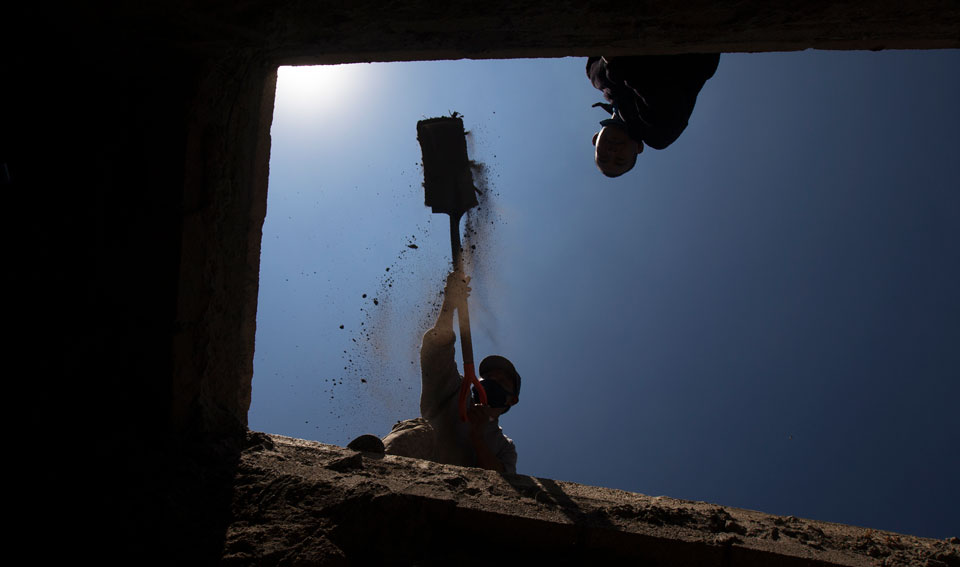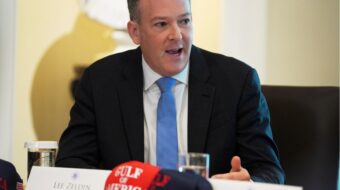
WASHINGTON—When it comes to battling the coronavirus pandemic, which has killed nearly a quarter-million people in the United States so far, medical experts are of one mind.
Vaccine or no vaccine—and we’ll get to that development in a moment—half the country still doesn’t wear masks, doesn’t social distance, crowds into arenas, bars, and restaurants, doesn’t wash their hands, and doesn’t sanitize often enough. That’s the situation now, and if it continues to be so, many more people will die. One expert predicts a million people cumulatively could be dead by March 1.
But if 95% take those protective measures, the death toll drops to 380,000 or so. And maybe by that time, vaccine distribution will be proceeding apace.
A total of 242,755 Americans have died of COVID-19 as of Nov. 12. Currently, 65,368 people nationwide are hospitalized, a peak for the pandemic. Some 10.4 million have become infected in the country. On Wednesday, Nov. 11, another record was broken, as 142,755 people tested positive in a single day. For the past week, new daily cases have averaged 128,081, a 69% increase from the average two weeks ago.
As President-Elect Joe Biden noted, one of every 33 Americans has tested positive. That’s larger than the combined populations of the nation’s largest (New York) and fifth-largest (Phoenix) cities. The death toll equals the population of Irving, Texas, former stadium site for the NFL’s Dallas Cowboys.
In short, when it comes to whether and when a vaccine to immunize people against the coronavirus and its modern-day plague becomes available for all, experts—including Dr. Anthony Fauci, the nation’s top virus specialist—say there’s still a way to go. In the meantime, keep wearing masks, washing hands, sanitizing, and keeping your distance.
That could be the situation possibly all the way through next year, Fauci and three colleagues warned in a top medical journal article last month. They didn’t say when those requirements would stop.
Biden says the same thing. He says wearing masks protects yourselves and your neighbors. Indeed, he called it a patriotic duty, regardless of race, creed, or political party. Current Oval Office occupant Donald Trump is another matter.
“This is going to require a national response, not just from elected leaders but from all of us,” Biden announced Nov. 8 in Wilmington, Del. “It’ll mean more significant and radical changes in personal behavior.”
One hopeful sign came the next day, when Pfizer CEO Albert Bourla announced preliminary results, not reviewed by peers or in scientific journals yet, of its first clinical trial of a coronavirus vaccine. A vaccine needs to go through at least four trial steps before it gets a final federal OK. The vaccine prevented the virus in 90% of recipients. Half of the group got the vaccine in two doses. The other half got placebos.
“The vaccine candidate was found to be more than 90% effective in preventing COVID-19 in participants without evidence of prior infection in the first interim efficacy analysis,” Bourla said, using the virus’s official name.
“The results demonstrate our mRNA-based vaccine can help prevent COVID-19 in the majority of people who receive it. This means we are one step closer to potentially providing people around the world with a much-needed breakthrough to help bring an end to this global pandemic,” he explained. mRNA stands for messenger ribonucleic acid, which transmits genes from DNA. It’s never been used to make anti-viral vaccines before.
“This is a first but critical step in our work to deliver a safe and effective vaccine.” To investors, Bourla cautioned: “I just ask everybody to be a little bit patient. You never know until you have a study readout.”
Still, he predicted production of 50 million doses of this COVID-19 vaccine, for the experimental trial, by the end of this year, and a billion next year. The Pfizer vaccine requires two doses, so the initial batch for 2020 will be enough to cover 25 million people.
There are other problems though. A big one is the need for refrigerated transportation. Pfizer’s vaccine must be shipped at a constant temperature of 90 degrees below zero Fahrenheit. Otherwise, it spoils.
Nevertheless, Pfizer’s announcement heartened Fauci. “I trust Pfizer. . I’ve known and worked with them for years. I trust the FDA [Food and Drug Administration].” If it’s shown to be effective, “I will take the vaccine myself and have my family take it,” he told NBC.
But in the meantime, National Institutes of Health Director Dr. Francis Collins cited a mathematical model from the University of Washington School of Public Health which shows that with no improvement in mask-wearing and other anti-viral measures, the cumulative death toll could soar to a million by the end of February—and that is regardless of any vaccine news.
That’s the worst case, he adds. Dr. Collins figures that when the U.S. death rate hits eight per million people per day, states will reimpose massive closures. Those measures would cut the cumulative deaths to 510,000, the study says. If 95% of the public wore masks, another 130,000 people would be saved.
“In other words, if most Americans pulled together to do the right thing and wore a mask in public, this simple, selfless act would save more than 130,000 lives in the next few months alone. If mask-wearers increased to just 85%, the model predicts it would save about 96,000 lives across the country.
“What’s important here aren’t the precise numbers. It’s the realization that, under any scenario, this pandemic is far from over, and, together, we have it within our power to shape what happens next. If more people make the decision to wear masks in public today, it could help to delay—or possibly even prevent—the need for future shutdowns. As such, the widespread use of face coverings has the potential to protect lives while also minimizing further damage to the economy and American livelihoods.”
Somebody needs to drum that into Trump. He’s refusing to concede he lost the presidential race to Biden, and that means the official transition between his regime and the incoming Biden government is hampered by restrictions on contacts, reports, national security issues—and briefings on current crises, with the virus at the top.
In late October, the Trump administration essentially surrendered to COVID-19. That’s when Chief of Staff Mark Meadows declared, “We’re not going to control the virus.” Despite earlier waving the white flag, Trump and those in his coterie at the White House are now trying to claim credit for the Pfizer vaccine. The company has reminded the public, however, that it did not participate in Trump’s much-vaunted “Operation Warp Speed” vaccine funding initiative.
As for public health measures, the outgoing president’s refusal to wear a mask egged on his followers to do likewise all through the summer and into the fall. As a result, coronavirus infection rates are again soaring. The number of confirmed cases in Trump’s inner circle is also spiking once again—Meadows and HUD Secretary Ben Carson are among those testing positive in recent days—making clear that the White House itself remains a coronavirus hotspot.
Biden, however, is establishing a work-around to counter Trump’s refusal to even attempt to fight the virus. He’s convened his own 13-member panel of coronavirus consultants, all of them physicians and specialists, to use the best scientific evidence in advising him on what to do to combat the pandemic. And unlike Trump, he promised to listen and follow their advice.
Even before that, Biden, who like coronavirus victims’ families has known the early death of loved ones, promised the group will provide him with “detailed plans, built-in science, and requiring compassion, care, and empathy at its core” to battle the virus.

He also plans to “build a corps of contact tracers” to find people who have been in contact with coronavirus sufferers, 45% of whom don’t show symptoms. The point, he said, is to test those contacts, too, again through a widened program telling them whether they’re coronavirus-positive and what to do.
“This will track and curb this disease while we prioritize getting vaccines out, first to health care workers and the most-at-risk populations, protecting workers and the public, and scaling up life-saving treatments and therapeutics.”
“And when it’s ready,” his administration will be “making sure an effective vaccine is distributed equitably, effectively, and free of charge.”
That’s not what Trump has done, and his blockade of access by the president-elect’s staffers threatens to slow things down. That’s why Biden set up his advisory panel. And he told a Nov. 10 press conference that he doesn’t expect Trump’s resistance will slow the transition to his government.
Meanwhile, in a case of poetic justice, the same day, Nov. 9, that Pfizer announced its vaccine in a press release, Dr. Collins’s National Institutes of Health published official clinical results of one Trump-trumpeted “cure,” for the coronavirus. The headline said it all:
“Hydroxychloroquine does not benefit adults hospitalized with COVID-19.”










